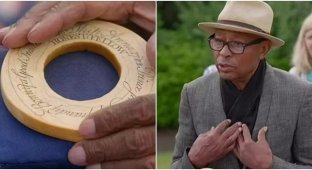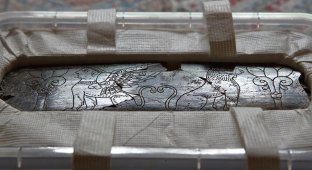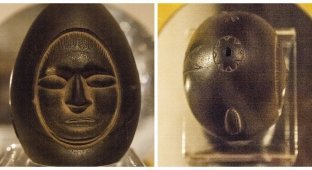From a jade pig to a mysterious automaton: 16 unusual artifacts from different eras and cultures (17 photos)
What do an ancient Chinese jade pig, a Japanese lacquer medicine box, and a mechanical monkey from Paris have in common? 
Each of these objects is not just an artifact, but a unique message from the past: a symbol of beliefs, technological breakthroughs, or curiosities of its era. This selection presents 16 amazing things that open up the unobvious boundaries of history.
1. Scepter of Darius I the Great 
The Dafineh Museum in Tehran has reopened after an eight-year hiatus, unveiling a new artifact that may be one of the most important relics of the ancient world. This is the scepter of Darius I the Great (522–486 BC). The gold and lapis lazuli piece was discovered in 1959 in the Apadana Palace in Persepolis.
2. Ivory Chess Set 
Rajasthan, India, 19th century.
3. Coronation Sandals of 10-Year-Old Sigismund II Augustus, King of Poland and Grand Duke of Lithuania 
Krakow, 1530. Scarlet velvet, silk and paper. Belongs to the National Museum in Krakow.
4. Ancient pig-shaped baby bottle found in a Messapian burial site (Manduria, Apulia, Italy) 
The item is approximately 2400 years old (4th century BC).
5. Jade plaque depicting three Taoist sages 
China, Qing Dynasty, 19th century.
6. Automaton in the form of a monkey 
Author unknown. Paris, circa 1850. Courtesy of the Science Museum Group and the Automaton Museum in Forres, Scotland.
7. Statue of the god Hanuman, created in the 18th century in South India 
Kept in the Denver Art Museum (USA).
8. Antependium (front wall of the altar), created by Pietro Piffetti in 1749 for the church of San Filippo Neri in Turin 
Made of mother-of-pearl, ivory, tortoiseshell, ebony, rosewood, jasper, lapis lazuli and other types of decorative stone.
9. Turin Cathedral Dome, Inside View 
Designed by the architect, priest and mathematician Guarino Guarini, completed in 1694. Badly damaged in a fire in 1997, it was restored in a complex 21-year restoration and reopened in 2018.
10. Two Cathars 
India, 18th century. An Indian dagger with an H-shaped handle, designed for stabbing. Often used as a ceremonial, hunting or combat weapon. A characteristic feature of the katar, as well as Indian weapons in general, is the decoration of the koftgari: the higher the status of the owner, the more complex and rich the decor used by the craftsmen: gold and silver inlay, cloisonné enamel, embossing.
11. Small jade pig 
China, Six Dynasties period (220–589 AD).
12. Ceramic figurine of a possum 
Ecuador, 1100–1520 AD
13. The Panagyurishte Treasure 
Vessel with concentric circles of African heads. Thracian culture, late 4th – early 3rd century BC (present-day Bulgaria).
14. Bust of Antonio Manuel ne Vunda, Ambassador of the Kingdom of Kongo to the Vatican 
Ne Vunda arrived in Rome on January 3, 1608, but died of illness two days later. The bust was created by Francesco Caporale for the ambassador's tomb in the Basilica of Santa Maria Maggiore.
15. Ritual wine vessel in the shape of an owl 
Late Shang Dynasty (c. 1600–1046 BCE). Collection of the Smithsonian Institution (probably the National Museum of Asian Art, Washington).
16. Japanese inro box with dragonfly motif, 19th century 
A small multi-tiered box (usually 5–10 centimeters) worn on the obi belt along with a netsuke (counterweight). It was used to store medicine, seals, or tobacco. It peaked in popularity during the Edo period (1603–1868), but production continued into the 19th century.



























